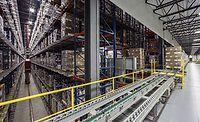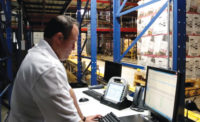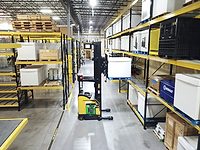Managing day-to-day operations in a busy beverage warehouse requires many factors to work together in order to move products from Point A to Point B. Warehouse management systems (WMS), working in tandem with a warehouse control system (WCS), are helping warehouse operators locate and track large inventories, optimize fulfillment strategies and help companies cost-effectively deliver products.
Regardless of the size of a warehouse, a best-of-breed WMS will result in near-perfect inventory accuracy and the complete traceability of products, experts note.
“Most wholesalers utilize WMS and WCS systems as a way to optimize fulfillment strategies to improve overall performance. A strong WMS system, in combination with a [warehouse execution system] (WES), WCS [and learning management software] (LMS), is able to manage workflow inside of the warehouse while taking into account things like truck departure time, route stop, truck sequencing, operator picking path and performance to ensure [that an] operation is running as smoothly as possible,” explains Andreas Oy, vice president of food and beverage at SSI Schaefer, Charlotte, N.C. “Additionally, a robust WMS system will provide real-time reporting to alert supervisors to a potential issue before it becomes an actionable item. WMS systems can also track labor productivity.
“Real-time operator productivity in conjunction with orders moving through the system for maximum traceability and supply chain visibility are all key factors for operations management,” Oy continues. “Understanding exactly where your product is and where it went are key performance indicators that help wholesalers collaborate with suppliers, bottlers and retailers.”
Beverage wholesalers are looking to WMS operations to help them manage the ever-changing nature of the industry, workplace dynamics as well as the proliferation of SKUs, says Larry Edelson, marketing director for Vermont Information Processing (VIP), Colchester, Vt.
“Not only has everyone felt the impact of an exploding SKU count in their portfolios, but the SKUs keep changing as suppliers continue to roll out new offerings,” Edelson says. “In addition, the workforce is changing. As a result, distributors need systems that are easy to use, easy to train on and are flexible enough to suit their needs.
“The benefits of WMS solutions are numerous,” he continues. ”Distributors will see improvements in accuracy, productivity [and] accountability, as well as reductions in training time, but most of all, they’ll see improvements in customer service. Through the use of WMS solutions, orders can be picked faster, loaded on trucks and sent out on time for delivery. This, coupled with more accurate orders, all leads to happier customers.”
Nancy Malone, software solution sales director at Grand Rapids, Mich.-based Viastore Systems Inc., echoes similar sentiments. “Wholesalers are utilizing WMS/WCS systems in the beverage industry to automate their material handling processes in the face of such challenges as just-in-time demand, smaller quantity orders, the increase in SKUs to support customization and consumer variety, labor issues, increased regulations and the need for optimal storage volume, speed, flexibility and scalability,” she says.
Minneapolis-based High Jump’s Vice President of Supply Chain Solutions’ Jon Kuerschner notes the importance of investing in agile technology, particularly as new selling channels, like click-and-collect models, have further challenged warehouse operations.
“There is growing awareness about the benefits that come with implementing adaptable (and scalable) fulfillment solutions — younger companies are investing in it based on projected growth rather than current revenues,” he says.
Functional Control
Dave Williams, director of software and solutions delivery for Westfalia Technologies Inc., York, Pa., says that no matter the size of an operation, a WES, which combines a tightly integrated WMS and WCS into a single application, can help operations managers direct, control and optimize internal material flow and order picking.
“This two-in-one method utilizes one single system to perform the tasks of both a WMS and a WCS,” Williams explains. “The WES technology simplifies communication and controls, and exchanges are not complicated by duplicated data or controls. With its modular capability, a WES enables companies of all sizes to select only the modules they need to handle their warehousing processes.”
Westfalia’s Savanna.Net platform offers a flexible, modular WMS and a fully integrated WCS that simplifies communication to ensure that controls and exchanges are not complicated by duplicated data or controls. The client-driven system also enables companies of all sizes to select only the modules that they need to enhance their warehousing processes.
SSI Schaefer’s Head of IT Solutions Mark Dickinson notes that large beverage distributors, in particular, can reap the benefits from a robust WMS/WCS. He points to the company’s WAMAS, which provides key performance indicators, operational performance and real-time directives for order fulfillment along with storage and pick-pack performance optimization.
He also suggests choosing a software provider with the versatility and capability to handle storage, picking and packing. “Beverage companies should look for WMS/WCS software that’s flexible and easily integrates with [enterprise resource planning] (ERP) systems, automation systems, scanners, palletizers and transportation systems.”
Suppliers continue to innovate new WMS applications. For example, Viastore offers viadat, which can process data in sub-seconds and return the work tasks to the equipment equally as fast, Malone says.
VIP recently introduced two new browser-based WMS applications: EasyPick, a voice-pick system, and EasyOps, an intuitive system that puts the power of managing the warehouse into a smartphone or tablet.
When it comes to choosing WMS/WCS software, SSI Schaefer’s Dickinson suggests that companies look at scalable systems.
“If the software has a roadmap that includes key features critical to the success of a future business plan, then look at the organization supporting it,” he explains. “WMS systems tend to be refreshed every 10 to 15 years, with an ongoing investment in upgrades and dedicated IT development staff and support.
“The effect that a WMS/WCS solution brings to a facility that includes automation is complete visibility into each facet,” he continues.
Viastore’s Malone stresses the importance of selecting a WMS provider with demonstrated real-time processing and decision-making abilities that expand beyond single operating directives.
“Islands of automation can be defined as disparate systems that are installed to manage only [automated storage and retrieval systems] (ASRS), [automated guided vehicles] (AGVs), conveyors, shuttles [and] carousels that do not speak directly to the WMS/WCS,” she explains. “To implement the best solution, a great WMS/WCS ties all of this information together and controls the flow of goods accurately and most cost effectively throughout the operations.”
Experts predict that accessible, configurable and scalable software-as-a-service (SaaS) WMS solutions will continue to advance.
“We’ve seen clients invest more in buy online, pickup in-store technology. Therefore, stores and dark stores become mini distribution centers that place greater value on inventory accuracy, process efficiencies and fulfillment metrics,” HighJump’s Kuerschner says. “The shift to omnichannel requires inventory visibility and traceability to maintain profitable margins while hitting high customer service expectations.” BI






